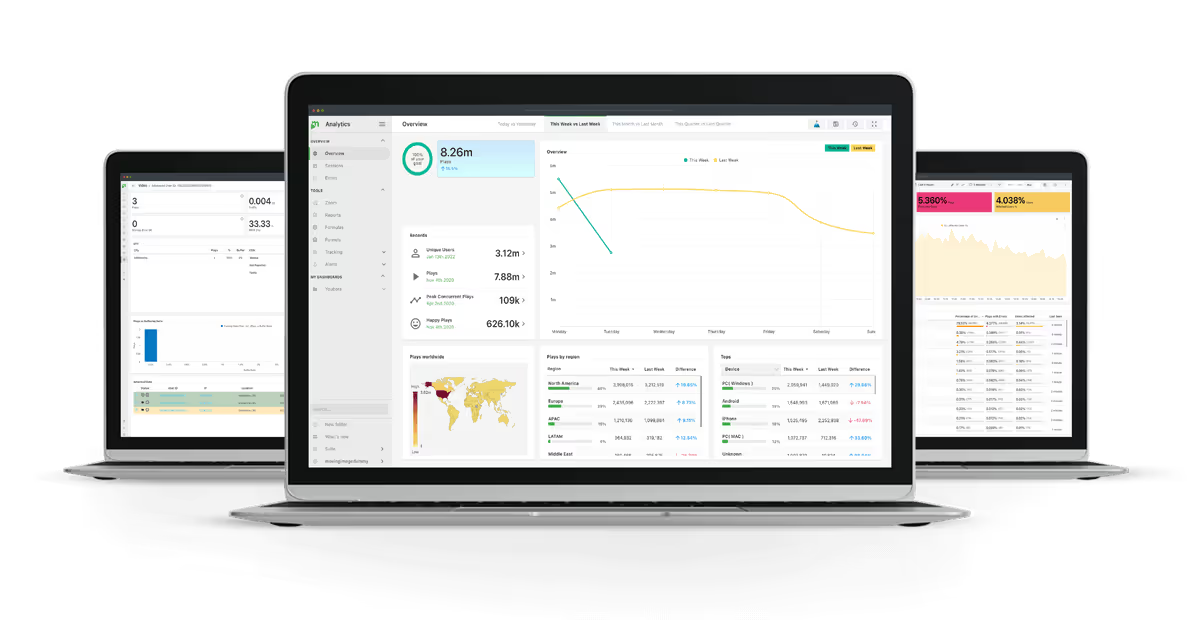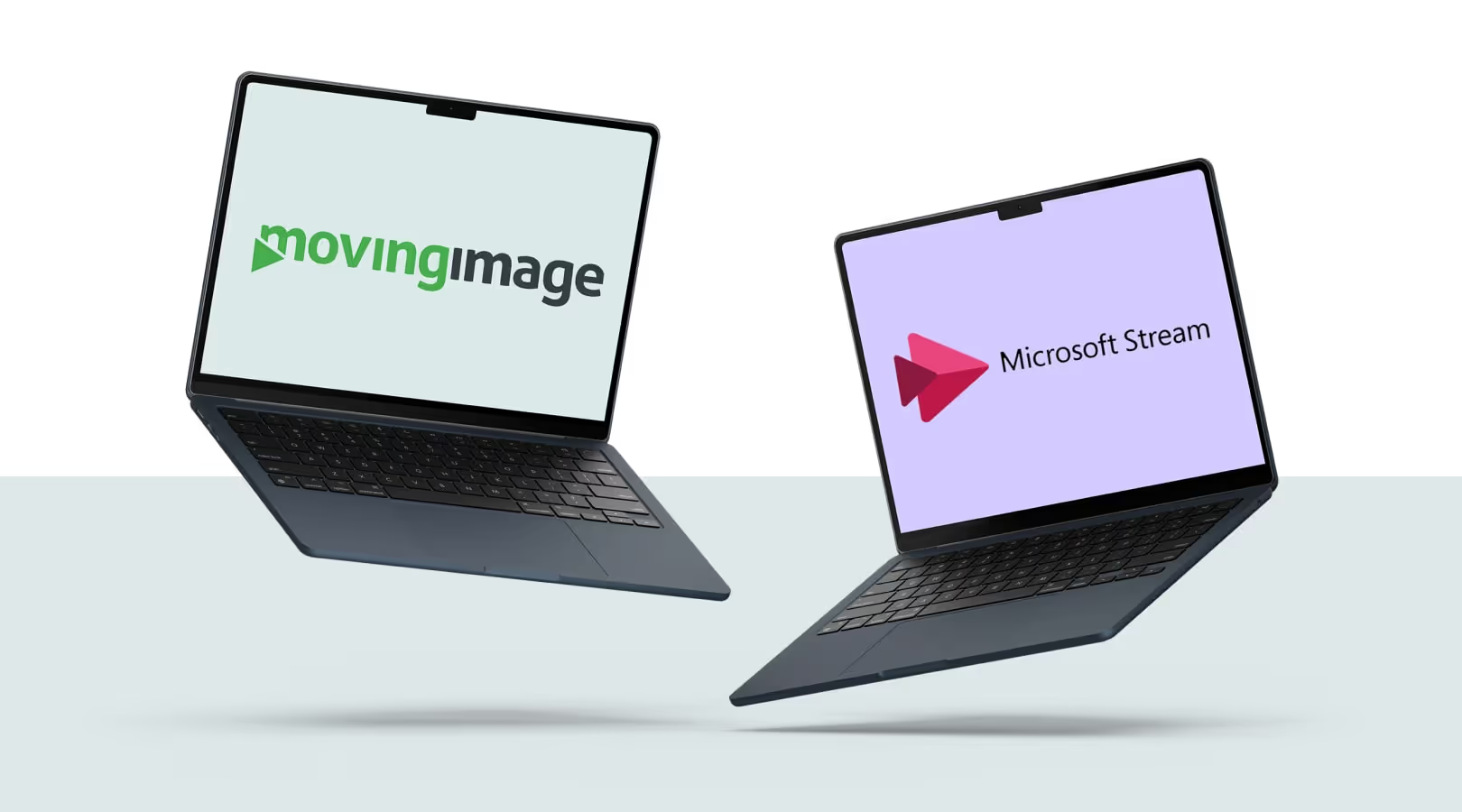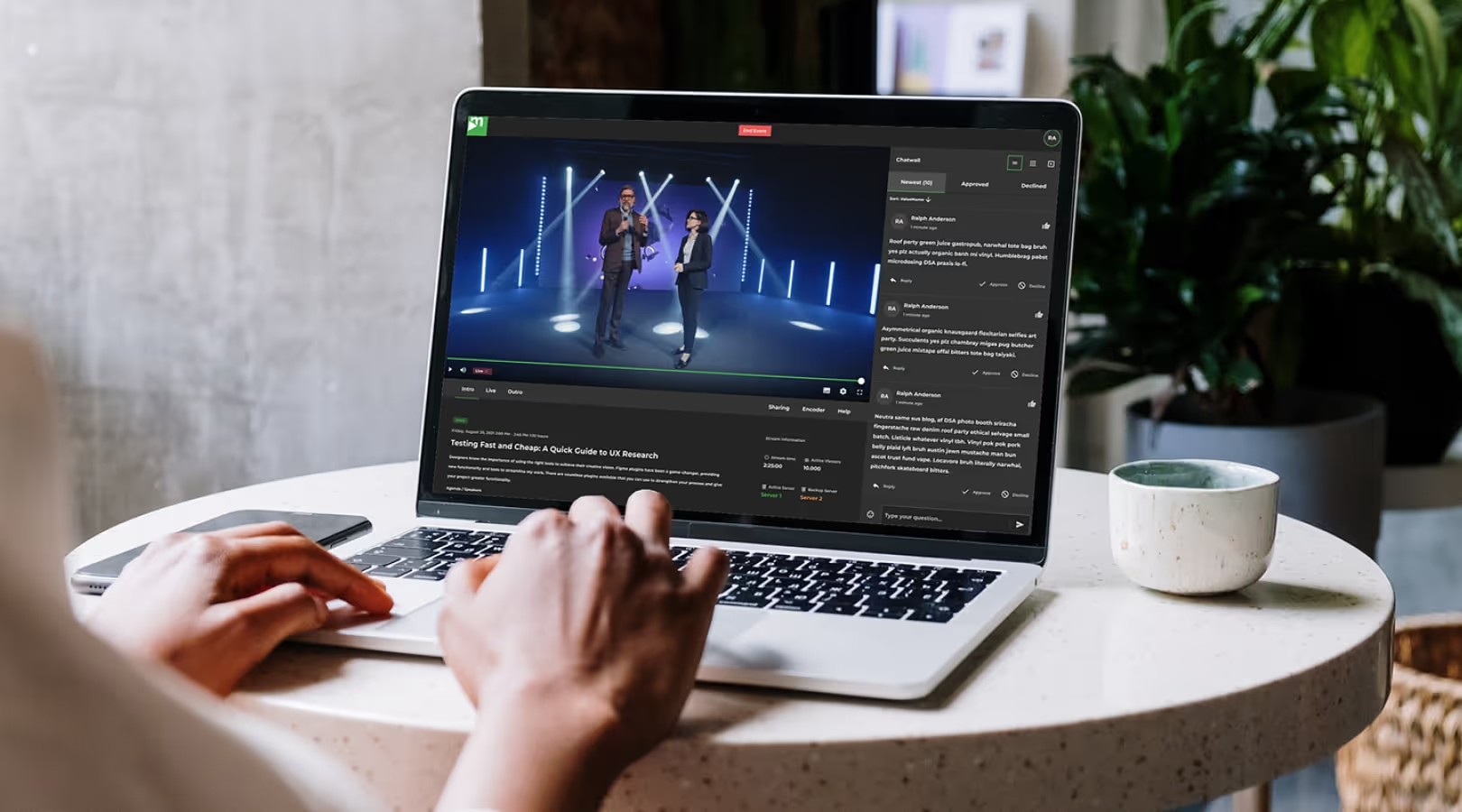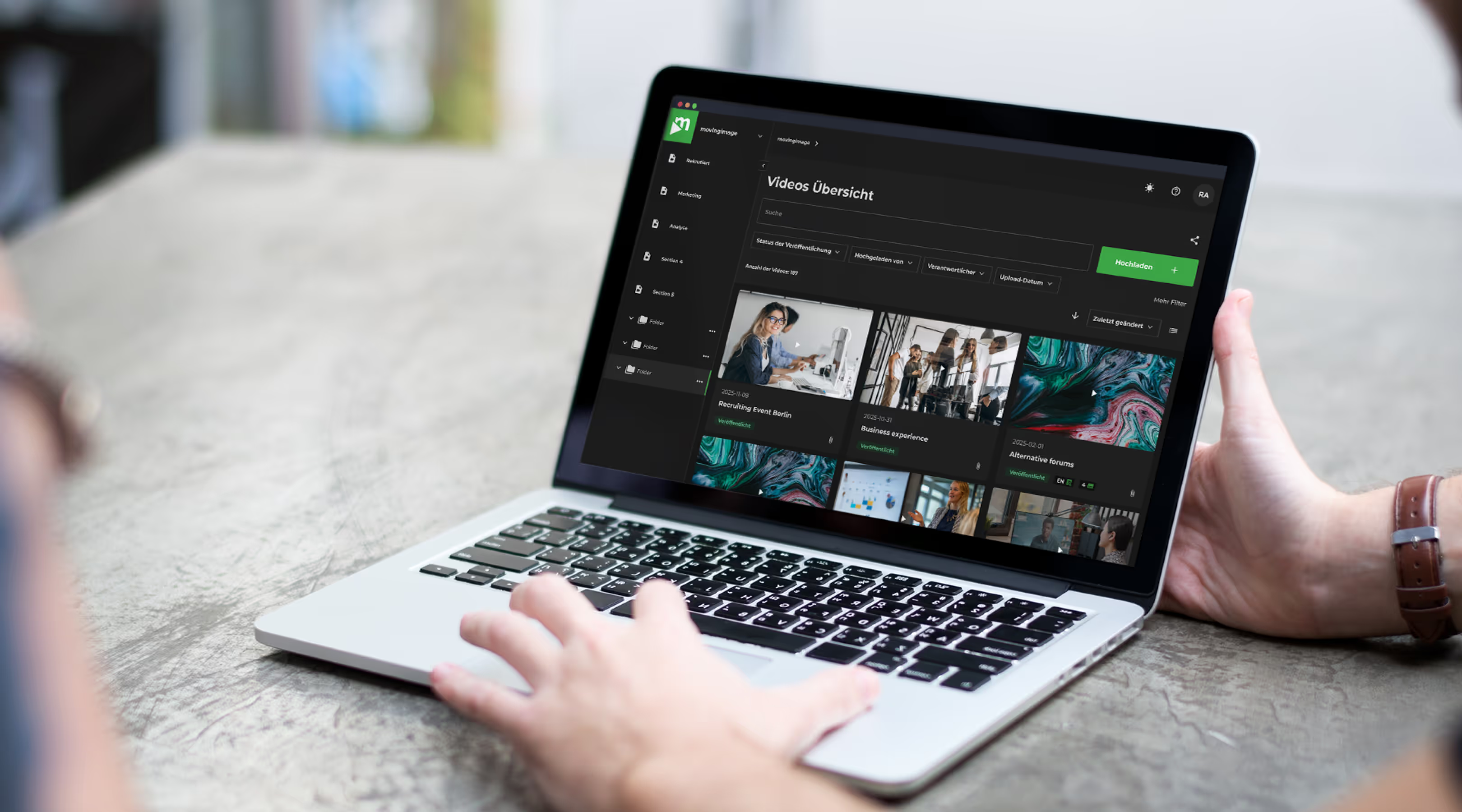Video analytics & metrics: the ultimate guide to video KPIs

Driving your success with video

Video analytics & metrics: the ultimate guide to video KPIs
But how do you decide whether your new video is a success? And how do you define success when it comes to video content?
The first answer lies in video analytics. A video analytics system gives you valuable insights into how your content is consumed, who’s watching it, and how it contributes to your goals.
The second answer is found in defining the right key performance indicators and measuring the relevant metrics. Only then can data be correctly interpreted and meaningful conclusions drawn.
In this comprehensive guide to video analytics, we’ll take a close look at:
- the role video analytics plays in shaping and executing a video strategy
- which video KPIs you should track and analyze
- where video analytics creates real value through specific use cases
- what the future of video analytics looks like
- and how movingimage Video Analytics can support you in analyzing your content

What are video analytics metrics – and why are they so important?
Measuring and analyzing metrics is a fundamental part of any successful video strategy. Only by doing so can you make informed decisions and steer your campaigns in the right direction.
You could spend countless hours planning, filming, and fine-tuning every detail of your video before making it available to your target audience—on the internet or your organization’s intranet. But if you’re not tracking the right metrics, you’ll never know whether the effort was worth it.
Video analytics systems provide companies with real-time insights into how individual videos are performing and help you understand your audience and what type of content truly resonates.
Performance analysis of videos involves tracking a wide range of metrics to provide context on how the content is consumed. The focus lies on viewer interaction as well as on viewer-related data.
Key metrics include performance indicators like play rate, watch time, or bounce rate, as well as demographic information such as viewer age or location.
Another type of video analysis that’s becoming increasingly important is Video Content Analysis (VCA). In contrast to quantitative performance metrics, VCA focuses on analyzing the actual content of a video.
Today, VCA is primarily used in security applications, such as automated evaluations of security camera footage. It is also used in process monitoring—for example, in manufacturing—to ensure quality in real time and to identify problems early on.
Both forms of video analysis benefit from the use of artificial intelligence (AI). In performance-based video analytics, AI already enables the interpretation of individual metrics and the identification of patterns and correlations.
For example, it might highlight that bounce rates are particularly high for certain videos when viewed after 4 p.m., or that videos under one minute in length tend to receive more clicks.
In content-based video analysis, AI already powers interesting use cases such as object, person, or location recognition, as well as the automatic cataloging of content to make it easier to find later.
Especially in the context of deep learning, more and more advanced methods are emerging—such as emotion analysis—which can lead to a deeper understanding of video content.
However, these tasks still require significant computing power and a mature software infrastructure. As technologies and algorithms continue to evolve, we can expect many more fascinating use cases in the years to come.

Video KPIs: key performance indicators and other essential metrics
Video metrics provide valuable insights into how and by whom your video content is being consumed. In this section, we introduce some of the most important KPIs for video content, explain what they measure, when they matter, and how you can optimize them.
Views (Plays)
What are views?
The number of views indicates how often a video has been played. It's the most basic video statistic and a good indicator of reach.
However, analyzing video views alone often leads to incorrect conclusions, since this metric only shows that a video was played—not who watched it, whether it was watched to the end, or whether it met the viewers’ expectations.
How are views measured?
A view is counted each time a video is played. Some platforms only count a view if the video has been watched for a minimum number of seconds.
How can you increase views?
- Share your video via email or social media
- Design an engaging thumbnail
- Give your video a compelling title
Play rate
What is play rate?
The play rate shows how often a video was played, expressed as a percentage rather than an absolute number. It’s a strong indicator of how appealing or relevant a video is.
How is play rate measured?
Play rate is calculated by dividing the number of views by the number of impressions.
How can you improve play rate?
- Create a compelling thumbnail
- Use a clear and relevant title
- Add subtitles to your video
- Embed your video on relevant web pages
Watch time
What is watch time?
Watch time indicates how long a video is watched on average. It reflects how engaging your content is. The higher the watch time, the more relevant or interesting your video is perceived to be.
Watch time is also a great metric for identifying content issues. If your one-minute video is watched for only 20 seconds on average, the content likely doesn’t meet viewers’ expectations.
How is watch time measured?
Watch time is the total duration your video has been watched, often expressed as an average by dividing total watch time by total views.
How can you improve watch time?
- Share relevant content
- Keep your videos short and focused
- Meet audience expectations
- Analyze where viewers tend to drop off
Completion rate
What is completion rate?
The completion rate indicates how often a video is watched all the way through. Expressed as a percentage, it complements watch time as a metric for video engagement.
How is completion rate measured?
The completion rate is the percentage of full video views divided by the total number of views.
How can you improve completion rate?
- Share relevant content
- Keep your videos short and to the point
- Tease a surprise or conclusion at the end
- Meet audience expectations
- Analyze drop-off points throughout the video
Engagement
What is engagement?
Engagement metrics show how and how often viewers interact with your video content. This includes likes, comments, and shares. Comments and likes provide direct insight into your audience’s feedback, while shares contribute to virality.
Engagement is important on every platform, but especially on social media, where engagement levels significantly impact organic reach.
How is engagement measured?
Engagement is typically measured as the total number of likes, comments, and shares. In some cases, engagement is expressed as a percentage—by dividing the number of engagements by the total number of video views.
How can you boost engagement?
- Prompt your audience to interact by asking questions or conducting polls
- Create polarizing or thought-provoking content
- Show your brand’s personality
Concurrent viewers
What are concurrent viewers?
Concurrent viewers refer to the number of people watching a video at the same time. This metric is especially relevant for livestreams, where content is broadcast and consumed in real time.
How is this metric measured?
Concurrent viewers are tracked in real time. The metric reflects how many viewers are actively watching your video simultaneously at any given point.
How can you increase concurrent viewership?
- Ensure your streaming infrastructure supports high traffic volumes
- Share a schedule for your livestream in advance
- Keep live content interactive and engaging to retain viewer attention
Click-through rate (CTR)
What is click-through rate?
CTR measures the percentage of viewers who click on the call-to-action (CTA) in your video.
How is CTR measured?
CTR is calculated by dividing the number of CTA clicks by the total number of video views.
How can you improve CTR?
- Highlight the benefits of clicking the CTA for your viewers
- Experiment with different wording for your call-to-action
- Clearly communicate what action you want your audience to take
Conversion rate
What is the conversion rate?
The conversion rate of a video measures the percentage of viewers who complete a defined conversion event after watching the video. This could be placing an order in an online shop or submitting a contact form.
In other words, your conversion rate shows how effectively your videos contribute to your business goals.
How is the conversion rate measured?
The conversion rate is calculated by dividing the number of conversions by the total number of video views.
How can you improve your conversion rate?
- Make sure your video links to the right landing pages
- Optimize your video for the platform or channel it’s published on
- Clearly communicate the benefits of taking the desired action
- Experiment with different content and messaging
Demographics
What are demographics?
The demographic data of your video audience provides insights into who is watching your content. This can include geographic location, devices used, age, gender, and viewer interests.
Demographics help determine whether you’re reaching the right audience. Combined with other KPIs, they offer a detailed picture of how your content is being consumed and by whom.
How are demographics collected?
Information like location and device is typically collected via IP addresses and user agents. Personal details such as age or gender are often pulled from user profiles, where available.
How can you improve demographic targeting?
- Make sure your videos are marketed effectively and accessible in all relevant regions
- Experiment with audience targeting settings
- Test new distribution channels

Use cases for video analytics across departments
The possible applications for video analytics tools are as diverse as the metrics they track. From optimizing marketing campaigns to sales enablement, onboarding new employees, or evaluating virtual and hybrid events—video analytics add value across many departments within an organization.
Video analytics for marketing teams
Every marketing video has the potential to become a viral hit—or flop entirely. Measuring the right video KPIs and ROIs gives marketing professionals valuable insights into the performance of their video campaigns.
This becomes especially important when videos are published across multiple platforms or used at different stages of the customer acquisition funnel. In these cases, a video analytics tool becomes a central source of information for comprehensive reporting.
Marketers use video to:
- Generate awareness for products and services
- Drive conversions
- Acquire new customers
- Boost website traffic
- Educate sales teams on new products or features
How marketers think about video:
- Do our customers enjoy watching our videos?
- What should our next video be about?
- Which video format creates the most impact?
- Are our sales teams actually using the new videos?
- Is our call to action strong enough?
- Are viewers staying engaged with our brand over time?
These are the insights marketers gain through video analytics:
- Which videos are best suited for each persona?
- What kind of content resonates with our target audience?
- Which videos drive the highest engagement and reach?
- Which videos lead to the desired conversions—and which don't?
- Where is our campaign budget being used most effectively?
Video analytics for sales teams
Video offers sales teams valuable opportunities to automate processes, share more personalized pitches with potential customers, and enable knowledge transfer—even across distributed teams.
Every member of your sales team, from SDRs to CSMs, benefits from a well-optimized video sales strategy and the insights provided by a video analytics tool.
Sales teams use video to:
- Capture the attention of potential leads
- Scale communication processes
- Share knowledge across the team
- Run product demos
- Showcase testimonials and success stories
- Stand out from the competition
How sales teams think about video:
- Which videos are best for nurturing prospects?
- How do I start conversations with new leads effectively?
- Which parts of our product demos are the most engaging—and which are not?
- Which training materials are most frequently used by my teammates?
These are the insights sales teams gain through video analytics:
- How much time do prospects spend watching our videos
- At which points do viewers drop off?
- Are our training materials being used effectively?
- Which features or services capture the most attention?
- Do videos outperform text in outreach efforts?
Video analytics for human resources
Video is a major trend in HR departments—and for good reason! HR videos are far more effective at attracting new employees and enable more personal communication with the workforce than static text ever could.
For many people teams, video is already an integral part of communication—whether in recruiting and onboarding or for training and company policies.
HR teams use video to:
- Strengthen employer branding
- Increase the reach of job postings
- Welcome new team members
- Automate onboarding processes
- Implement targeted training programs
- Facilitate management communication
How HR teams think about video:
- Are our videos reaching the right candidates?
- How can I position our company as an attractive employer?
- Are new employees learning everything they need to be successful?
- Does management have the right visibility across the company?
These are the insights HR teams gain through video analytics:
- How much time do teams or individuals spend on training content?
- Who is showing interest in the company?
- How are employees consuming company updates?
Video analytics for event teams
The transformation of the event industry has brought many event formats into the digital age. In addition to simple “one-to-many” livestreams, virtual and hybrid event formats have now become a standard part of many companies’ event strategies.
For organizers and planners, this opens up completely new opportunities to measure the performance and success of an event in real time, optimize it, and adapt future events accordingly.
Event teams use video to:
- Stream events
- Maximize reach
- Promote events effectively
- Make content available even after the event
How event teams think about video:
- How can I design content to deliver a positive experience for all participants?
- How can I generate more registrations for my events?
These are the insights event teams gain through video analytics:
- Which content, speakers, or topics are in demand?
- How much reach was achieved?
- How many participants were active at the same time?
- How do recordings perform compared to the live event?

The future of video analysis: AI-powered video content analysis (VCA)
While performance-based video analytics offer deep insights into how video content is consumed, another important area of video analysis focuses on the actual content of a video.
This field is known as video content analysis (VCA), which involves extracting metadata from raw video footage. These data points can be used for applications such as search, categorization, summarization, and event detection.
In VCA, video and audio files are transformed into meaningful elements. The analysis is powered by algorithms designed to process videos for specific tasks. VCA has many use cases, especially in the fields of security, process optimization, and automation.
Artificial intelligence is playing an increasingly important role in these scenarios by improving the quality and efficiency of the analysis. In these cases, the term intelligent video analytics is often used.
Video content analysis has made significant strides in recent years. Today, it already enables the detection, identification, and categorization of faces, colors, and various objects—such as license plates or manufactured goods.
Some of the top applications of video content analysis include:
- Object detection
Identifies and categorizes objects in a video—for example, detecting whether a car or a beverage bottle appears in the footage. - Shape recognition
Analyzes shapes within a video, often used to support object detection. - Motion detection
Identifies relevant movements in a video—useful for detecting break-ins or other unexpected events. - Facial recognition
Plays a crucial role in many security systems, enabling both the recognition and differentiation of faces. - Video tracking
Tracks the position or movement of people or objects in relation to an external reference grid.
The most exciting aspect of AI-powered video analysis is its ability to learn continuously, making it more accurate over time. The more video material available to machine learning algorithms, the better they become at distinguishing between valid and false signals.
As both algorithms and hardware continue to evolve, we can expect to see significantly more complex and powerful applications emerge in the near future.

Use cases for video content analysis across industries
The most common applications of advanced video content analysis currently lie in the field of security. These include incident detection, intrusion prevention, traffic surveillance, people counting, facial recognition, and many other areas. Beyond these examples, however, video content analysis is increasingly becoming an essential component in process optimization across a variety of industries.
Video analytics in retail
Retail companies can leverage AI-driven video content analysis to optimize operations and enhance the customer experience—without adding labor or operational costs.
Video analysis provides recommendations for improved checkout strategies and more efficient queue management. Automated people counting also delivers insights into shopper behavior, such as identifying which displays receive the most attention or how different customer cohorts move through the store.
Video analytics in manufacturing and logistics
Using video analytics along the supply chain gives companies in manufacturing and logistics a completely new way to monitor safety protocols and optimize processes to the benefit of both the business and its customers.
Intelligent cameras combined with video analytics can track individual products and their condition, streamlining the management of large inventories. In addition, business intelligence applications powered by smart cameras can reduce downtime by predicting potential disruptions or production delays and immediately alerting staff to take corrective action.
Throughout the entire manufacturing and shipping process, smart cameras help monitor packaging conditions and detect open or damaged boxes—automating one of logistics' most persistent challenges.
Video analytics in finance
Video analysis software enables banks and financial institutions to improve security and situational awareness. Existing surveillance systems can be used not only to respond to incidents in real time, but also to search and filter video footage after an event has occurred.
Facial recognition enhances the quality of evidence for law enforcement and offers stronger protection for assets. In some cases, demographic information such as gender and approximate age can also be gathered, helping financial institutions target their marketing more precisely and tailor the customer experience accordingly.

Video analytics software from movingimage
With movingimage Analytics, you have access to a tool that delivers clear, intuitive statistics. It not only allows you to track your video performance, but also helps you understand your audience and identify which video content truly resonates.
Analyze your video performance in real time
Combine your data, calculate averages, and use dimensions to keep track of your KPIs and visualize success. For example, you can measure video plays, unique users, or average watch time.
Get to know your audience better
Only by understanding your viewers can you optimize your video content. Track which devices your videos are viewed on, how people interact with them, and where your audience is located.
Generate unlimited reports
Configure an unlimited number of reports and choose who receives them and how often they’re sent by email. This saves you valuable time.
Use your video budget efficiently
Which videos performed well and which didn’t? Based on insights from past campaigns, you can learn to allocate your video budget more effectively. Clear dashboards and automated reports also help simplify your day-to-day tasks.
Our Speakers
But how do you decide whether your new video is a success? And how do you define success when it comes to video content?
The first answer lies in video analytics. A video analytics system gives you valuable insights into how your content is consumed, who’s watching it, and how it contributes to your goals.
The second answer is found in defining the right key performance indicators and measuring the relevant metrics. Only then can data be correctly interpreted and meaningful conclusions drawn.
In this comprehensive guide to video analytics, we’ll take a close look at:
- the role video analytics plays in shaping and executing a video strategy
- which video KPIs you should track and analyze
- where video analytics creates real value through specific use cases
- what the future of video analytics looks like
- and how movingimage Video Analytics can support you in analyzing your content

What are video analytics metrics – and why are they so important?
Measuring and analyzing metrics is a fundamental part of any successful video strategy. Only by doing so can you make informed decisions and steer your campaigns in the right direction.
You could spend countless hours planning, filming, and fine-tuning every detail of your video before making it available to your target audience—on the internet or your organization’s intranet. But if you’re not tracking the right metrics, you’ll never know whether the effort was worth it.
Video analytics systems provide companies with real-time insights into how individual videos are performing and help you understand your audience and what type of content truly resonates.
Performance analysis of videos involves tracking a wide range of metrics to provide context on how the content is consumed. The focus lies on viewer interaction as well as on viewer-related data.
Key metrics include performance indicators like play rate, watch time, or bounce rate, as well as demographic information such as viewer age or location.
Another type of video analysis that’s becoming increasingly important is Video Content Analysis (VCA). In contrast to quantitative performance metrics, VCA focuses on analyzing the actual content of a video.
Today, VCA is primarily used in security applications, such as automated evaluations of security camera footage. It is also used in process monitoring—for example, in manufacturing—to ensure quality in real time and to identify problems early on.
Both forms of video analysis benefit from the use of artificial intelligence (AI). In performance-based video analytics, AI already enables the interpretation of individual metrics and the identification of patterns and correlations.
For example, it might highlight that bounce rates are particularly high for certain videos when viewed after 4 p.m., or that videos under one minute in length tend to receive more clicks.
In content-based video analysis, AI already powers interesting use cases such as object, person, or location recognition, as well as the automatic cataloging of content to make it easier to find later.
Especially in the context of deep learning, more and more advanced methods are emerging—such as emotion analysis—which can lead to a deeper understanding of video content.
However, these tasks still require significant computing power and a mature software infrastructure. As technologies and algorithms continue to evolve, we can expect many more fascinating use cases in the years to come.

Video KPIs: key performance indicators and other essential metrics
Video metrics provide valuable insights into how and by whom your video content is being consumed. In this section, we introduce some of the most important KPIs for video content, explain what they measure, when they matter, and how you can optimize them.
Views (Plays)
What are views?
The number of views indicates how often a video has been played. It's the most basic video statistic and a good indicator of reach.
However, analyzing video views alone often leads to incorrect conclusions, since this metric only shows that a video was played—not who watched it, whether it was watched to the end, or whether it met the viewers’ expectations.
How are views measured?
A view is counted each time a video is played. Some platforms only count a view if the video has been watched for a minimum number of seconds.
How can you increase views?
- Share your video via email or social media
- Design an engaging thumbnail
- Give your video a compelling title
Play rate
What is play rate?
The play rate shows how often a video was played, expressed as a percentage rather than an absolute number. It’s a strong indicator of how appealing or relevant a video is.
How is play rate measured?
Play rate is calculated by dividing the number of views by the number of impressions.
How can you improve play rate?
- Create a compelling thumbnail
- Use a clear and relevant title
- Add subtitles to your video
- Embed your video on relevant web pages
Watch time
What is watch time?
Watch time indicates how long a video is watched on average. It reflects how engaging your content is. The higher the watch time, the more relevant or interesting your video is perceived to be.
Watch time is also a great metric for identifying content issues. If your one-minute video is watched for only 20 seconds on average, the content likely doesn’t meet viewers’ expectations.
How is watch time measured?
Watch time is the total duration your video has been watched, often expressed as an average by dividing total watch time by total views.
How can you improve watch time?
- Share relevant content
- Keep your videos short and focused
- Meet audience expectations
- Analyze where viewers tend to drop off
Completion rate
What is completion rate?
The completion rate indicates how often a video is watched all the way through. Expressed as a percentage, it complements watch time as a metric for video engagement.
How is completion rate measured?
The completion rate is the percentage of full video views divided by the total number of views.
How can you improve completion rate?
- Share relevant content
- Keep your videos short and to the point
- Tease a surprise or conclusion at the end
- Meet audience expectations
- Analyze drop-off points throughout the video
Engagement
What is engagement?
Engagement metrics show how and how often viewers interact with your video content. This includes likes, comments, and shares. Comments and likes provide direct insight into your audience’s feedback, while shares contribute to virality.
Engagement is important on every platform, but especially on social media, where engagement levels significantly impact organic reach.
How is engagement measured?
Engagement is typically measured as the total number of likes, comments, and shares. In some cases, engagement is expressed as a percentage—by dividing the number of engagements by the total number of video views.
How can you boost engagement?
- Prompt your audience to interact by asking questions or conducting polls
- Create polarizing or thought-provoking content
- Show your brand’s personality
Concurrent viewers
What are concurrent viewers?
Concurrent viewers refer to the number of people watching a video at the same time. This metric is especially relevant for livestreams, where content is broadcast and consumed in real time.
How is this metric measured?
Concurrent viewers are tracked in real time. The metric reflects how many viewers are actively watching your video simultaneously at any given point.
How can you increase concurrent viewership?
- Ensure your streaming infrastructure supports high traffic volumes
- Share a schedule for your livestream in advance
- Keep live content interactive and engaging to retain viewer attention
Click-through rate (CTR)
What is click-through rate?
CTR measures the percentage of viewers who click on the call-to-action (CTA) in your video.
How is CTR measured?
CTR is calculated by dividing the number of CTA clicks by the total number of video views.
How can you improve CTR?
- Highlight the benefits of clicking the CTA for your viewers
- Experiment with different wording for your call-to-action
- Clearly communicate what action you want your audience to take
Conversion rate
What is the conversion rate?
The conversion rate of a video measures the percentage of viewers who complete a defined conversion event after watching the video. This could be placing an order in an online shop or submitting a contact form.
In other words, your conversion rate shows how effectively your videos contribute to your business goals.
How is the conversion rate measured?
The conversion rate is calculated by dividing the number of conversions by the total number of video views.
How can you improve your conversion rate?
- Make sure your video links to the right landing pages
- Optimize your video for the platform or channel it’s published on
- Clearly communicate the benefits of taking the desired action
- Experiment with different content and messaging
Demographics
What are demographics?
The demographic data of your video audience provides insights into who is watching your content. This can include geographic location, devices used, age, gender, and viewer interests.
Demographics help determine whether you’re reaching the right audience. Combined with other KPIs, they offer a detailed picture of how your content is being consumed and by whom.
How are demographics collected?
Information like location and device is typically collected via IP addresses and user agents. Personal details such as age or gender are often pulled from user profiles, where available.
How can you improve demographic targeting?
- Make sure your videos are marketed effectively and accessible in all relevant regions
- Experiment with audience targeting settings
- Test new distribution channels

Use cases for video analytics across departments
The possible applications for video analytics tools are as diverse as the metrics they track. From optimizing marketing campaigns to sales enablement, onboarding new employees, or evaluating virtual and hybrid events—video analytics add value across many departments within an organization.
Video analytics for marketing teams
Every marketing video has the potential to become a viral hit—or flop entirely. Measuring the right video KPIs and ROIs gives marketing professionals valuable insights into the performance of their video campaigns.
This becomes especially important when videos are published across multiple platforms or used at different stages of the customer acquisition funnel. In these cases, a video analytics tool becomes a central source of information for comprehensive reporting.
Marketers use video to:
- Generate awareness for products and services
- Drive conversions
- Acquire new customers
- Boost website traffic
- Educate sales teams on new products or features
How marketers think about video:
- Do our customers enjoy watching our videos?
- What should our next video be about?
- Which video format creates the most impact?
- Are our sales teams actually using the new videos?
- Is our call to action strong enough?
- Are viewers staying engaged with our brand over time?
These are the insights marketers gain through video analytics:
- Which videos are best suited for each persona?
- What kind of content resonates with our target audience?
- Which videos drive the highest engagement and reach?
- Which videos lead to the desired conversions—and which don't?
- Where is our campaign budget being used most effectively?
Video analytics for sales teams
Video offers sales teams valuable opportunities to automate processes, share more personalized pitches with potential customers, and enable knowledge transfer—even across distributed teams.
Every member of your sales team, from SDRs to CSMs, benefits from a well-optimized video sales strategy and the insights provided by a video analytics tool.
Sales teams use video to:
- Capture the attention of potential leads
- Scale communication processes
- Share knowledge across the team
- Run product demos
- Showcase testimonials and success stories
- Stand out from the competition
How sales teams think about video:
- Which videos are best for nurturing prospects?
- How do I start conversations with new leads effectively?
- Which parts of our product demos are the most engaging—and which are not?
- Which training materials are most frequently used by my teammates?
These are the insights sales teams gain through video analytics:
- How much time do prospects spend watching our videos
- At which points do viewers drop off?
- Are our training materials being used effectively?
- Which features or services capture the most attention?
- Do videos outperform text in outreach efforts?
Video analytics for human resources
Video is a major trend in HR departments—and for good reason! HR videos are far more effective at attracting new employees and enable more personal communication with the workforce than static text ever could.
For many people teams, video is already an integral part of communication—whether in recruiting and onboarding or for training and company policies.
HR teams use video to:
- Strengthen employer branding
- Increase the reach of job postings
- Welcome new team members
- Automate onboarding processes
- Implement targeted training programs
- Facilitate management communication
How HR teams think about video:
- Are our videos reaching the right candidates?
- How can I position our company as an attractive employer?
- Are new employees learning everything they need to be successful?
- Does management have the right visibility across the company?
These are the insights HR teams gain through video analytics:
- How much time do teams or individuals spend on training content?
- Who is showing interest in the company?
- How are employees consuming company updates?
Video analytics for event teams
The transformation of the event industry has brought many event formats into the digital age. In addition to simple “one-to-many” livestreams, virtual and hybrid event formats have now become a standard part of many companies’ event strategies.
For organizers and planners, this opens up completely new opportunities to measure the performance and success of an event in real time, optimize it, and adapt future events accordingly.
Event teams use video to:
- Stream events
- Maximize reach
- Promote events effectively
- Make content available even after the event
How event teams think about video:
- How can I design content to deliver a positive experience for all participants?
- How can I generate more registrations for my events?
These are the insights event teams gain through video analytics:
- Which content, speakers, or topics are in demand?
- How much reach was achieved?
- How many participants were active at the same time?
- How do recordings perform compared to the live event?

The future of video analysis: AI-powered video content analysis (VCA)
While performance-based video analytics offer deep insights into how video content is consumed, another important area of video analysis focuses on the actual content of a video.
This field is known as video content analysis (VCA), which involves extracting metadata from raw video footage. These data points can be used for applications such as search, categorization, summarization, and event detection.
In VCA, video and audio files are transformed into meaningful elements. The analysis is powered by algorithms designed to process videos for specific tasks. VCA has many use cases, especially in the fields of security, process optimization, and automation.
Artificial intelligence is playing an increasingly important role in these scenarios by improving the quality and efficiency of the analysis. In these cases, the term intelligent video analytics is often used.
Video content analysis has made significant strides in recent years. Today, it already enables the detection, identification, and categorization of faces, colors, and various objects—such as license plates or manufactured goods.
Some of the top applications of video content analysis include:
- Object detection
Identifies and categorizes objects in a video—for example, detecting whether a car or a beverage bottle appears in the footage. - Shape recognition
Analyzes shapes within a video, often used to support object detection. - Motion detection
Identifies relevant movements in a video—useful for detecting break-ins or other unexpected events. - Facial recognition
Plays a crucial role in many security systems, enabling both the recognition and differentiation of faces. - Video tracking
Tracks the position or movement of people or objects in relation to an external reference grid.
The most exciting aspect of AI-powered video analysis is its ability to learn continuously, making it more accurate over time. The more video material available to machine learning algorithms, the better they become at distinguishing between valid and false signals.
As both algorithms and hardware continue to evolve, we can expect to see significantly more complex and powerful applications emerge in the near future.

Use cases for video content analysis across industries
The most common applications of advanced video content analysis currently lie in the field of security. These include incident detection, intrusion prevention, traffic surveillance, people counting, facial recognition, and many other areas. Beyond these examples, however, video content analysis is increasingly becoming an essential component in process optimization across a variety of industries.
Video analytics in retail
Retail companies can leverage AI-driven video content analysis to optimize operations and enhance the customer experience—without adding labor or operational costs.
Video analysis provides recommendations for improved checkout strategies and more efficient queue management. Automated people counting also delivers insights into shopper behavior, such as identifying which displays receive the most attention or how different customer cohorts move through the store.
Video analytics in manufacturing and logistics
Using video analytics along the supply chain gives companies in manufacturing and logistics a completely new way to monitor safety protocols and optimize processes to the benefit of both the business and its customers.
Intelligent cameras combined with video analytics can track individual products and their condition, streamlining the management of large inventories. In addition, business intelligence applications powered by smart cameras can reduce downtime by predicting potential disruptions or production delays and immediately alerting staff to take corrective action.
Throughout the entire manufacturing and shipping process, smart cameras help monitor packaging conditions and detect open or damaged boxes—automating one of logistics' most persistent challenges.
Video analytics in finance
Video analysis software enables banks and financial institutions to improve security and situational awareness. Existing surveillance systems can be used not only to respond to incidents in real time, but also to search and filter video footage after an event has occurred.
Facial recognition enhances the quality of evidence for law enforcement and offers stronger protection for assets. In some cases, demographic information such as gender and approximate age can also be gathered, helping financial institutions target their marketing more precisely and tailor the customer experience accordingly.

Video analytics software from movingimage
With movingimage Analytics, you have access to a tool that delivers clear, intuitive statistics. It not only allows you to track your video performance, but also helps you understand your audience and identify which video content truly resonates.
Analyze your video performance in real time
Combine your data, calculate averages, and use dimensions to keep track of your KPIs and visualize success. For example, you can measure video plays, unique users, or average watch time.
Get to know your audience better
Only by understanding your viewers can you optimize your video content. Track which devices your videos are viewed on, how people interact with them, and where your audience is located.
Generate unlimited reports
Configure an unlimited number of reports and choose who receives them and how often they’re sent by email. This saves you valuable time.
Use your video budget efficiently
Which videos performed well and which didn’t? Based on insights from past campaigns, you can learn to allocate your video budget more effectively. Clear dashboards and automated reports also help simplify your day-to-day tasks.



.avif)


.avif)






.avif)





